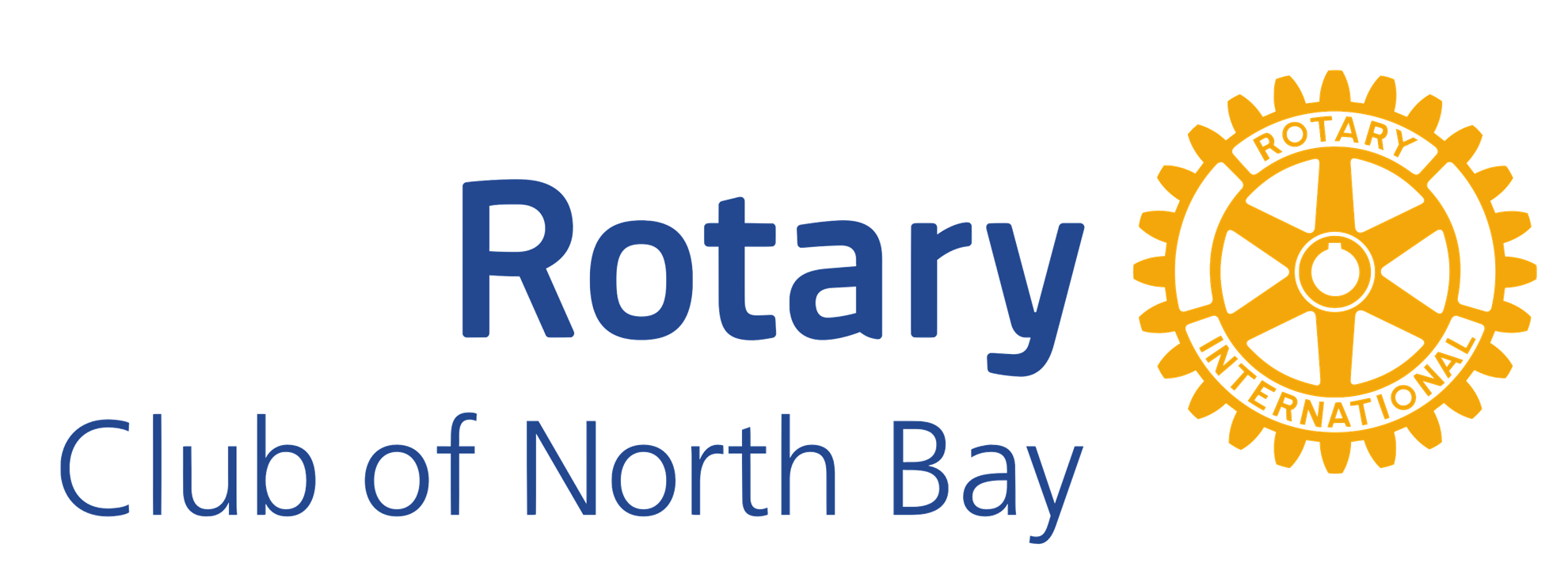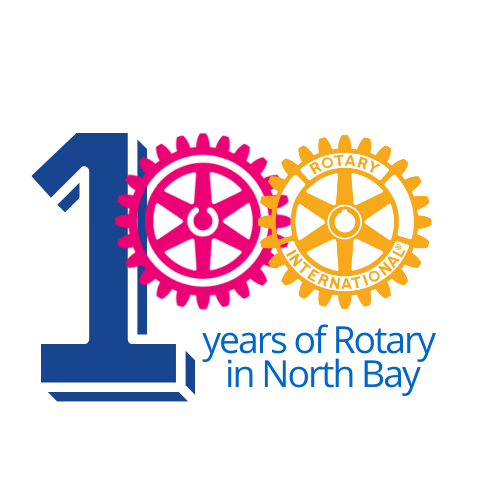Kathy Hallett's Classification Talk
.JPG) President Natalie and fellow Rotarians
President Natalie and fellow RotariansGood Afternoon. It is a pleasure to speak to you and share a little about my life experiences and family.
I was born in Toronto and lived in several towns between Toronto and Windsor until we finally settled in Brampton when I was in grade 8. (This is a picture of a painting of our family home. It was painted by my sister Maureen).
I am the eldest of twelve children with 6 brothers and 5 sisters (Pat, Peggy, Maureen, Mary, Mike, Colleen, Dan, Jim, Gerry, Bob and Judy). The O'Neill clan!
My father was a veteran of WW11 and instilled in us the importance of family, education, hard work and Catholic Values. He worked 2 jobs for 80 hrs. a week to support the family. He passed away in 1980.
My mother worked at Canadian Car in Fort William during the war and later efficiently managed our household. There were always hot meals and baking. Sundays were family days and after church we would pile into the station wagon (seat belts weren't required back then) and go to the nearest park for recreation and in the good weather, picnics. There wasn't a lot of money but we always had what we needed. Mom passed away in 2002.
These pictures are of the extended family- my siblings and their spouses; and 28 nieces and nephews. We endeavour to get together at least twice a year: Boxing Day for skating, shinny hockey and refreshments, and August for our O'Neill golf tournament. Some of us golf and some of us just hit balls around the course.
After high school in Brampton I spent almost a year in and out of hospital recuperating from a car accident. A moveable object hit an immoveable object. Not good!
Next I attended the University of St. Michaels College, University of Toronto; Toronto Teachers' College and The Ontario Institute for Studies in Education and graduated with a Masters of Sociology in Education. My studies focused on marginalized groups, and various cultural groups.
I was married to Graham Hallett in 1971 and we moved to Haileybury. My first teaching job was in Cobalt when one of the first Junior Kindergarten classes in the northeast was opened up in St. Patrick's School.
In 1975 we moved to the North Bay area where I spent most of my educational career with the Nipissing -Parry Sound Catholic District School Board and its predecessor board. We also raised our two children: Bryce is an animator with his small company Frogfeet Productions in Toronto and Jackie is a law clerk working in Toronto. She is also a qualified sommelier. In 1996 their father and I parted ways.
In 2011 I married Marcel Bourdeau who has three wonderful children; Andrea who is a software engineer in Ottawa and Matt and Christine who are working in North Bay but not sure of their career paths yet.
Early in my career I began to take additional qualification courses to enhance my teaching skills and I took many opportunities to combine these courses with travel. My Primary Specialist Qualifications were taken in London England in 1986. We had the opportunity to visit schools and meet with teachers. At St. Joseph's High Street we were learning how computers were being integrated in the classroom. At Regent Street School we were serenaded by students during their weekly assembly, and watched lessons being taught. The school playground was on the roof of the school since the school was located next to Regent canal.
My religious education qualifications were obtained in Israel through OECTA and the Catholic Bible Society. Here we are exploring Tel Arad in the Negev Desert. We were immersed in the historical, political and religious backgrounds of the country and got our feet wet in the Jordan River at Yardenet.
Subsidized by the Ontario and German governments, a group of us toured Germany and Denmark in 1990 to learn about their educational and political systems. In Copenhagen, we visited a technical school where students were learning to become opticians. Near Roskilde, young students spent time at Lejre which is an iron age village. Students had to carve their own utensils before they could eat. A great hands on learning experience!
After several years in various roles in the board I was seconded to the Northeastern office of the Ministry of Education as part of Integrated Services for Northern Children. I monitored Section 27 programs for students who were blind, hearing impaired or in detention. I also liaised with the northeastern school boards from North Bay to Moosonee so I got to know the geography of a whole new area of Ontario.
In 1994 there was a push for improving literacy as well as the use of computers in the classroom. This is the grade one class at Ministik School in Moose Factory and this is the book room containing leveled books to improve the teaching of reading.
After working for the Ministry, I became a Superintendent of Education for the Catholic Board and was responsible for schools, programmes, special education and staff development. In this role I became involved with several community committees and agencies. This led to my volunteer involvement with the Family Enrichment Programme, Crisis Centre and YES Employment which continues to date.
I retired from the Nipissing-Parry Sound Catholic DSB in 2003 and got a 6-year contract as Supervisory Officer for James Bay Lowlands Secondary School Board in Moosonee which also had an agreement for services with Moose Factory Island District School Area Board and Moosonee Roman Catholic Separate School Board. I would fly in for two weeks, visit the staffs of the three schools and work with the three different school boards and their various committees. Then I would have two weeks at home in Callander.
This experience increased my awareness of the Cree Culture, as well as knowledge of the James Bay coastal communities, and of the difficulties people experience in isolated areas.
There was an agreement between the James Bay Lowlands board and the band in Kasechewan to supervise the secondary courses to ensure they met provincial standards so the students could obtain an Ontario graduation diploma. This is a picture of Francine J. Wesley School and part of the community. After years of flooding you can see the high-water marks on the walls of the schools and note many resources have been damaged.
There are many challenges up north and one is transportation. For the students on Moose Factory Island, getting to the provincially funded secondary school in Moosonee was an adventure. They travelled by the ice road in winter. At freeze up and break up they travelled by helicopter and in warmer weather they used water taxis.
In between jaunts to Moosonee and working at home, I did more travelling.
When one of my nieces went to Australia for university in 2006 I travelled to Australia with my sister Mary to see her and tour the country. We had a few days in the outback at Uluru which is a sacred area for the Aboriginal people. James talked about life in the desert and how they got resin from the bushes. Wangin warmed the resin so it would stick in a ball and this was called "Making Kiti". I don't remember what it was used for. As in many cultures, women carried things on their heads as they walked. The bowl dropped off my head shortly after this picture was taken. The issues and historical treatment of the Aboriginal people in Australia are similar to some of those experienced by our own Indigenous people.
Back in Moosonee, since there is no public library some young mothers brought Dolly Parton's Learning Library to the community to encourage parents to read to their children. Minister of Education Kathleen Wynne came to the launch of this initiative as well as MP Charlie Angus and MPP Gilles Bisson.
After that event, I did more travelling. This time it was to Morocco. One of our stops was "Ait Ben Haddou" which is a ksar near the town of Ouarzazate. In this ancient complex where eight families still live, there is no electricity and no running water. Ali earns money by showing tourists through his home - here he demonstrates how flour is ground. He also takes bit parts in movies such as "The Gladiator" that are filmed at this site.
Travelling on a camel-like a Berber to the Erg Chebbi dunes at the edge of the Sahara Desert was a fun experience and a glimpse of another lifestyle. Young girls were weaving rugs in the nearby tents while the men looked after the camels and tourists. The women made meals and refreshments.
I fully retired in 2009 and thus had more time for various hobbies, reading, and touring. I was fortunate to join Sandy Foster on two trips to Kenya with "Hope 2 Kenya'. We worked with women's groups and in schools. This is a grade 5 class at Sirende School near Kitale. I enjoyed reading to the students and doing some limited teacher in-service. The building of several of the classrooms was funded by the efforts of Sandy Foster.
In Kenya, there also was also time for a safari in the Masai Mara and a balloon ride.
In Nairobi, we visited Kigulu school in the Kibera slum. It was a little haven for the children and gave them a chance for a hot meal each day. In the village of Kasavai food was distributed and a community school was built through Hope 2 Kenya. We met a young boy who was hearing impaired and now he is sponsored to attend St. Anthony's School for the deaf in Webuye. His mother is not well and his father who was a "Boda Boda" driver was recently killed.
Lastly this is Aiya who showed us around the Baisha Naxi Embroidery Institute in Baisha Village near the city of Dali in Yunnan Province in China. At a young age, girls learn the skills and the art of fine silk embroidery which is found on clothing and in pictures. The school seemed to have a good environment.
I first became aware of Rotary activities through a former neighbour. Sandy Foster later brought me to a couple of meetings when we made presentations about Kenya. When I met Cathy Whiting and Bill Hagborg at other meetings their discussions regarding Rotary tweaked my interest. I have always valued service to community and believe this organization will provide new opportunities to serve, as well as to expand my network. I am especially interested in the Guatemala Literacy Project and in Children's literacy.
Thank you for listening.

